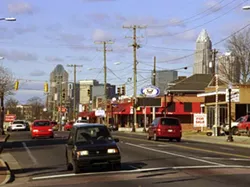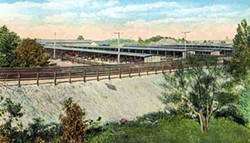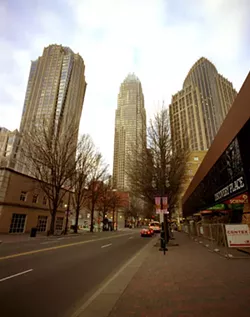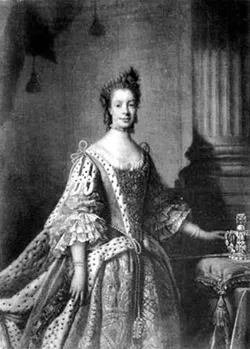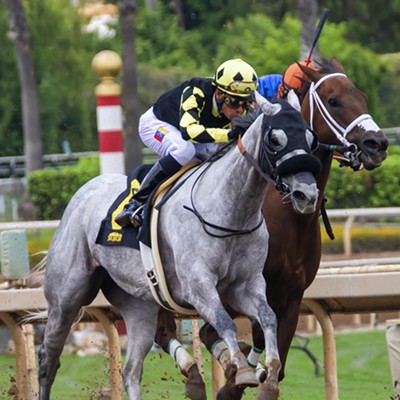You ever drive down Sharon Road and ask yourself, "Who the hell is Sharon anyway?"
No?
Well, we -- the editors and writers at Creative Loafing -- asked ourselves that very question. We wondered about the secret identity of Sharon ... and of Elizabeth, Wilkinson, Mint and a host of Charlotte's other city streets. Call us geeks.
Sure, maybe we have way too much time on our hands, but we can't be alone in our musings. So, for those other folks out there with a nose for historical facts, we've tracked down a handful of tales explaining the origins of the roads you travel down every day.
Wilkinson Boulevard
Driving down Wilkinson Boulevard today, one gets little hint that this thoroughfare was once the pride of North Carolina's road system.
Before the advent of the U.S. interstate system, Wilkinson Boulevard was the widest, most-traveled route in and out of Charlotte. Indeed, Wilkinson was the first four-lane paved highway in the state when it opened in 1926, says Tom Hanchett, historian at the Levine Museum of the New South.
In 1921, Gov. Cameron Morrison charged a new state highway commission with building roads with proceeds from a mind-boggling $50 million bond issue. The program gave North Carolina the reputation as the "good roads" state. "They didn't have anything like that in the South," Hanchett says. "That's one of the reasons why Charlotte is what it is and why North Carolina is what it is ... the state decided to tax itself and build highways at a point when that was a rare thing to do."
Wilkinson stretched from Charlotte, where mill owners and businessmen who served the mills lived, to Gaston County, which Hanchett says "had more looms and spindles than any other country in the world."
No surprise then, that the man at the helm of the commission was William Cook Wilkinson, a Charlotte banker and textile mill owner. Wilkinson started working at Merchants and Farmers Bank at age 16. By 1919, he was bank president. He also was president of the Lowell Mills. A 1939 Charlotte News article explained the boulevard's moniker this way: "By reason of its exceptional construction and the community's high regard for the commission, the highway was given his name."
By the 1980s, Wilkinson Boulevard was associated with, as a 1985 Charlotte Observer article described it, "topless bars, fast food restaurants and vacant lots." Other news reports of the day noted the surging illegal drug trade and prostitution that plagued the corridor's struggling business owners. The city tried to step in with a $10 million to $20 million plan to revitalize the area. Is it revitalized now? Weelll....
Beatties Ford Road
The Beatties Ford Road name has carried such historical import among some Westside residents that many haven't wanted the three-mile road, which stretches through a predominantly black neighborhood, renamed after Dr. Martin Luther King Jr.
At least twice -- in 1976 and 1990 -- according to reports in the Charlotte News and the Charlotte Observer, city planners have considered such a proposal. Each time, it has been discarded with the exhortation to find a better street to honor King.
Beatties Ford Road, home to institutions like Johnson C. Smith University, the Excelsior Club, West Charlotte High School and the city's first United House of Prayer for All People, hasn't always been associated with west Charlotte's African-American community. The road was named for John Beatty, an early landowner, according to Tales from the Hornet's Nest, by W. Hugh Harkey. A Scotts-Irish pioneer, Beatty was believed to be the first European to cross the Catawba River. Some of the earliest European settlers followed, building farms and plantations along Beatties Ford. The road later became a vibrant epicenter of west Charlotte. But later, at its worst, the road's reputation was blemished by crime and decay.
This February, Charlotte finally joined the legions of other cities in naming a street after King. The City Council voted unanimously to rename Second Street. And Beatties Ford Road has retained its historical name.
Elizabeth Avenue
Elizabeth Avenue started out as a humble dirt road leading to Elizabeth College, a Lutheran women's college named after Anne Elizabeth Watts. Tobacco big-wig Gerald Watts fronted the cash for the impressive two-story brick building (present-day location of Presbyterian Hospital) named after his wife in 1897. Despite the somber Victorian era, Elizabeth College emerged as a vibrant campus. The Charlotte-Mecklenburg Historic Landmarks Commission states that the college frequently hosted concerts, and cheeky pictures posted on the CMHLC Web site show Elizabeth College girls posing with basketballs, flirty smiles and (gasp!) showing bare arms.
Eventually, the dirt road was paved, and Elizabeth Avenue was born. In the 1900s, Elizabeth Avenue was the place to be. Elizabeth became the first suburb on the eastern side of Charlotte, following the trendy Dilworth on the southern side. In 1903 a trolley line was built, connecting Elizabeth Avenue and Hawthorne Lane to the city's center, and Elizabeth Avenue experienced a residential boom. Most of the city's upper crust could be found real estate shopping on Elizabeth; among those were department store mogul William Henry Belk (yes, that Belk) and several prominent city leaders. In later years, Elizabeth was the home of humorist and writer Harry Golden; his buddy Carl Sandburg was a frequent visitor to his home and to the bustling avenue.
Elizabeth Avenue continues to be a place for the daring and artistic, and home to the vibrant college campus of Central Piedmont. The girls of Elizabeth College would be proud.
Rocky River Road
The road in the northeastern edge of the county that was once home to rough-edged bars was formerly called Jackass Road, the Charlotte News reported in a 1975 article on strange local road names (stored in the Carolina Room at the Uptown branch of the public library). When the road was paved for the first time, and the paper didn't say when that was, the locals decided to change its name.
"Somebody figured all that macadam made the street too fancy for its name," the paper reported. Until 1956 in the city and 1965 in the county, people could name a road whatever they wanted -- and apparently did.
Central Avenue
According to the writings of local historians Hanchett and Dan Morrill, Central Avenue, a major thoroughfare from Uptown through Charlotte's eastside, was called "Lawyer's Road" for the first century of its 200-year life. Back then, lawyers would travel the dirt road past farms on their way to Wadesboro, where the nearest courthouse was located.
Then in 1899, two local developers created Piedmont Park, which ran along Lawyer's Road from Seventh Street outward for a half-mile. It was the city's first neighborhood to use deed covenants and other tools to keep blacks and poor whites from moving into the neighborhood. Its developers, F. C. Abbott and George Stephens, rebuilt Lawyer's into a wide boulevard, befitting its new role as the entrance to elite east side neighborhoods. The street was then renamed Central Avenue, a name developers thought would sound better to upper-class homebuyers who were becoming increasingly willing to buy homes on what was then considered to be the "city's edge."
Remount Road
Remount, which connects South and Wilkinson boulevards, was named for an army "remount station" at Camp Greene during World War I, according to historical documents from the Carolina room. The station was maintained as a place for soldiers to secure their horses in between assignments.
Providence, Sharon and Sugar Creek
Early Charlotte settlers were Scotts-Irish Presbyterians whose worlds often revolved around home and church, local historian Tom Hanchett says.
"Presbyterians named a lot of early roads after the churches the road went to," Hanchett says. Providence Road got its name because it went from downtown to Providence Presbyterian Church. Sugar Creek Road went by Sugar Creek Presbyterian Church. Ditto for Sharon Road, which ran by Sharon Presbyterian Church.
It appears that early county residents may have taken this trend to the extreme. In the Bible, Hanchett points out, the plains of Sharon are next to Mount Carmel in Israel. Mount Carmel Presbyterian Church, in what is now known as the Carmel Road area, abuts the Sharon Road area.
Dick Road:
As previously stated, before 1956, street-naming occurred on a first-come, first-serve basis. Now if residents want to change their street name, petition approval of 60 percent of the residents is required. Names cannot exceed 21 letters, be named after a business, or be "possibly offensive."
Several years ago, a dispute over changing a "possibly offensive" name was heard in front of city council. In 1997, six residents of a dead-end street off Beatties Ford Road, between Kidd Lane and Miranda Road, met before the county commission to request not only a name change, but that the $300 street-renaming charge be waved. Unlike other street name changes made for "pleasure," this request was being made because the street name caused residents "ridicule, mockery and embarrassment." It's hard to decide which is funnier: the old street name Dick Road or their replacement choice, Cowboy Lane -- an obvious overcompensation for residents' injured pride.
At the commission, Scott Tucker, a Dick Road homeowner, testified that apart from the ridicule, mockery and embarrassment, the old name posed serious safety risks. In the past, emergency responders had gotten lost on calls because the street sign doesn't last very long on the post before someone steals it. (And what about all the cold pizzas they must suffer through?)
Robert Dick gave opposing testimony at the hearing, recounting the history behind his family name. But it wasn't enough. Cowboy Lane passed 7-2.
Alexander Street
City officials came to their senses in 1914 and gave some dreadfully dull downtown street names some meaning. B Street was changed to Brevard, C to Caldwell, D to Davidson and E to Alexander -- named after prominent founding families of Mecklenburg County, not individuals of those clans.
One famous Alexander, for example, was Joseph, a clergyman and educator who established Queens College. A staunch patriot, Joseph was credited with saving morale after the Battle of Camden. Most male members of his Presbyterian parish brought rifles to his Sabbath services during the topsy-turvy Tory days. Another Alexander, Hezekiah, led a group of patriots who adopted the Mecklenburg resolves, nullifying all British laws and authority. The royal government at the time wrote to England that the Mecklenburg Resolves were the most treasonable documents the continent had ever produced.
Sadly, a more modern and perhaps influential Alexander does not have a street named after him, although one is in the works. Frederick Douglas Alexander worked tirelessly to register blacks to vote in the '30s and '40s.
In 1961, Alexander bested a field of 41 candidates to become the city's first black councilmen since 1890. In the '60s he was Charlotte's leading champion for civil rights. Among other integration actions, Fred tore down a fence that segregated dead blacks in Pineville Cemetery and dead whites in Elmwood.
After Alexander passed away in 1980 there was some effort to rename Senior Drive, the street where he lived, in Fred's honor. The new Fred Alexander Road will be in the Mt. Holly/Brookshire Boulevard/Huntersville area.
Independence Boulevard
Shortly after World War II, Charlotte began growing like a well-fed little girl with low metabolism. Without a cross-town boulevard to help relieve some of the congestion that plagued Uptown streets, her pants were getting a little tight around the waist. Too tight for some people. When a brilliant engineer completed a street plan that included an expressway from Graham Street eastward along Stonewall to Sugar Creek, where one arm led to the Monroe and Albemarle highways and the other connected with Queens Road, city leaders were all for it.
That is, until citizens practically started a riot over it. According to the Charlotte-Mecklenburg Historic Landmarks Commission Web site, once they found out that the new expressway would split the Chantilly, Elizabeth, and Piedmont Park neighborhoods and a good chunk of the city's first public park would be victimized, it was on. The mayor at the time, Herbert Baxter, and members of the City Council backed down for a moment, most likely wiping sweat from their foreheads as infuriated folks continued to complain. But the submission would not last. When no other solution could be determined, the city council approved the plan, and construction was underway.
When it came time to name the new cross-town boulevard, city council notes from May 4, 1949 found in the Carolina Room, report that it was suggested that it be named after the mayor. Throwing out the modesty card, Herbert Baxter would have none of that. "How about naming it Independence Boulevard?" piped up City Clerk Lillian Hoffman. After all, the new expressway was built after sacrificing much of Independence Park.
It's too bad that Herbie said no because now state officials are asking the Charlotte Department of Transportation to change the section of Independence between 7th Street and Midtown; apparently the street name regularly befuddles motorists who confuse it with the highway. Doreen Szymanski of the Charlotte Department of Transportation says she has asked nearby Central Piedmont Community College for name recommendations.
Trade and Tryon
For those who know better, the corner of Trade and Tryon streets goes by a different name: the Square. According to Wikipedia.org, this major intersection actually began as ancient Native American trading paths.
Before the name Tryon was "tried on," this particular road was a part of the Great Wagon Road, one of the most heavily traveled major routes for settlers in America. The length of it slithered from pioneer-filled Pennsylvania to the great state of Georgia.
In 1755, Thomas Polk, the great uncle of U.S. President James Polk, built his home at the intersection of Great Wagon Road and a Native American trading path. This crossroad eventually gave birth to the little village of "Charlotte Town." As the city grew, Great Wagon Road was renamed Tryon Street, after William Tryon, the royal governor of colonial North Carolina right before the Revolutionary War. And the little trading path that Native Americans frequented? Trade Street, of course.
Runnymede Avenue
In the Old English, Runnymeade contains an "a," but the colonialists that named the avenue wanted to further remove themselves from the Brits from whence they came. Its name comes from the English meadow that sits on the bank of the Thames River, south of London. Here, the barons with an army raised against King John ("Soft Sword" so called for his inaptitude at warfare -- he was also, coincidentally, the last King John) in defense of their rights as landholders, forced the monarch to sign what became known as the Magna Carta.
Mint Street
The Mint Street moniker comes pretty matter-of-factly. It was the street that bordered the Charlotte Mint's eastern side during the days of the Carolina Gold Rush, the first in America. In 1799, a boy named Conrad Reed found a 17-pound gold nugget (that was later used as a doorstop due to ignorance on the part of the Reed family) in Meadow Creek in Cabarrus County. The mint opened in 1836 and once minted $5 million in "Carolina gold" in one year. Its doors finally closed in 1861.
All Hail Queen Charlotte!
Charlotte should be nicknamed the Cat City, not the Queen City. After all, isn't this the home of the Carolina Panthers, the 2003 NFC Champions? What about those ferocious felines, the Charlotte Bobcats? And if a recent cover story about "Crazy Cat Ladies" by Creative Loafing isn't enough to prove this city is run amuck with kitties, then what is?
But honestly, the QC nickname ain't going anywhere -- it's been around for ages.
According to the Charlotte Chamber of Commerce Web site, the QC was named for Queen Charlotte, the wife of King George III of the United Kingdom. She was the great, great, great, great grandmother of the current Queen Elizabeth II. Before she was chosen by George to be his wifey, she was German-born Charlotte of Mecklenburg-Strelitz. (Ever wonder where Mecklenburg County got its name?) Many of Charlotte's early inhabitants (we're talking about the city now, not the woman) were of Scotts-Irish or German descent. And back when North Carolina was a royal colony, the name was probably chosen to gain favor with the king.
Written by Branna Calloway, Natalie Howard, Kimberly Lawson, Jared Neumark, Tara Servatius, and Karen Shugart.
For further information, visit the Carolina Room at the Main Library or check out Mecklenburg: The Life and Times of a Proud People by Howard White.
Speaking of 4.86000
-
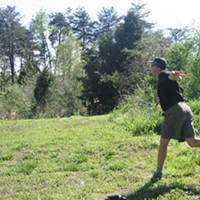
Disc-o Fever
Oct 4, 2006 -
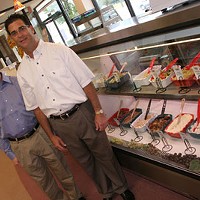
Deep Knish
Aug 2, 2006 - More »
Latest in Cover
Calendar
-

Wine & Paint @ Blackfinn Ameripub- Ballantyne
-

Face to Face Foundation Gala @ The Revelry North End
-
An Evening With Phil Rosenthal Of "Somebody Feed Phil" @ Knight Theater
-
Kountry Wayne: The King Of Hearts Tour @ Ovens Auditorium
-
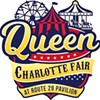
Queen Charlotte Fair @ Route 29 Pavilion
-
Canuck in the Queen City 7
A Canadian transplant looks back at her first year as a Charlotte resident
-
Homer's night on the town 41
If you drank a shot with the Knights mascot on Sept. 20, you were basically harboring a fugitive
-
Delic Holdings Inc. Announces Meet DELIC, the Premiere Psychedelic and Wellness Edutainment Event and Expo for Newcomers and Veteran Psychonauts, Announces Initial Speaker Lineup 42


